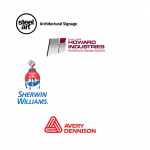Communication can be the bane of human existence. Well, okay, maybe it’s not the bane of human existence, but it sure can be a struggle. And when it comes to communicating your ideas to a sign expert, it’s no different. Even that can present challenges.
So we thought it would be worthwhile to offer you some ways to communicate and present ideas to your sign specialist—your newest partner in your company’s branding and marketing journey. Let’s explore tips to ease up potential difficulties and make your sign process a walk in the park.
Put it on paper
Of course, the first thing that comes to mind when we say “put it on paper” could easily be the idea of formally writing (or typing) things down. And while that’s a great idea that we’ll tackle in just a minute, the idea of “getting things on paper” can actually be broader than the printed word.
In fact, it may not even involve words at all. Sometimes, drawing out your ideas on paper or a nearby whiteboard can be invaluable. What you can easily envision, your specialist may not be able to visualize until you give him an example.
This can be especially true when you’re talking about some of the visual elements of design. Exactly what your logo concept looks like or how you want your text and visuals arranged on a billboard—those are things you may need to map out on paper or a whiteboard.
Don’t underestimate the power of scratching out a rough diagram. And in the modern age, everyone can carry your rapidly-drawn ideas with them by simply pulling out a smartphone and snapping photos of the drawings.
Write it down
Here’s where we actually get to talk about the value of writing or typing things on paper (or on the computer as the case may be). People can easily have an irrational fear of writing out their ideas. They may feel it boxes them in or ties them down. Or they just might be downright scared of writing because they have no idea what they want to say.

As hard as it is, writing ideas down captures them in an invaluable way. It also prompts a thought process that can be very useful to the success of your project. To actually write things down, you may have to think about them a little harder (or perhaps just a little differently) than you otherwise would.
Harness useful terminology (and define it)
Obviously, words are vital for communication. But not all words are equal in terms of importance or value. You might find that some keywords help you communicate better with your sign specialist than others.
For example, when you’re in early stages of sign design and you want to keep all your options open, try using the word, “conceptual” to refer to plans that aren’t set-in-stone. And for good measure, follow up your usage of the word with some helpful clarification about what you mean. In this case, you could just alert the person you’re corresponding with that these plans “may change over time.”
Give them something to go on
If you don’t have any experience in the sign industry (or the design industry), you may feel completely out of your depth. And you may find it challenging to understand what you want, let alone communicate it to others.
That’s why it can be useful to give your sign specialists examples. By pointing out signs, color palettes, and designs that you like, you offer them a window into your mind. Plus, you can take things a step further and articulate why you like what you like.
For instance, maybe you like black and white palettes because you find they communicate “modernity” and “stability.” Well, if you let your specialist know that, they may not only understand your needs better, but they may be able to help you do an even better job of fulfilling them.
Tap into the power of technology to help you out here by using these tools and methods:
- Share a Pinterest board of inspiration
- Take photos of signs you see around town and share them with your specialist
- Send your specialist photos of other companies’ signs you admire
Be clear
Remember to be both honest and clear when communicating with your sign company. We know it can be tempting to ease the burden of sharing difficult truths or opinions by being evasive or vague. But that tactic could hurt you and your signage partner in the long run.

That doesn’t mean you have to say everything you’re thinking every time. But it is a good reminder to say what needs to be said when it needs to be said—even if it makes you or other people feel a little uncomfortable.
Need examples? When you’re still undecided about a project or an element of a project, don’t string the sign company along by letting them think you’re all in. Communicate to them where you actually are in the decision-making process if you think it would help them make better plans of their own. In fact, it might even help them help you. And it may also prevent them from losing valuable resources like time and money.
When you don’t like something, say so. If it’s your job to sign off on project design, then be open about designs you don’t care for. We’ll venture a guess that most other designers would also prefer to be told “no” sooner rather than later. That way, they don’t waste time on a project element they’ll never ultimately use. And they hear “no” when they still have time to course-correct.
Great company, great communication
Of course, before you can invest in good communication with your sign company, you’ll need to actually find that sign company. Take some time to learn more about selecting a great sign specialist with our What To Look For From A Sign Making Company + Questions To Ask. And if you’re new to the wonderful world of signage, start bringing yourself up to speed with A Glossary Of Sign Definitions & The Distinctive Features Of Each.




